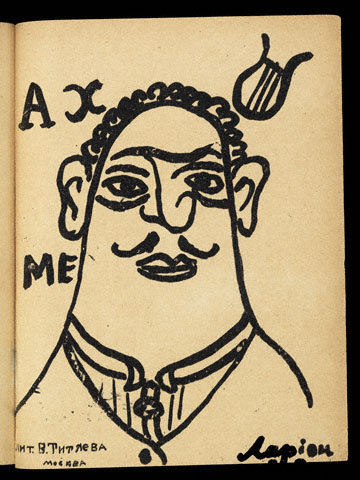Tango with Cows
dal 17/11/2008 al 18/4/2009
Segnalato da
Natalia Goncharova
Mikhail Larionov
Olga Rozanova
Kazimir Malevich
Vasily Kamensky
Alexei Kruchenykh
Velimir Khlebnikov
Mikhail Larionov
Nancy Perloff
Allison Pultz
17/11/2008
Tango with Cows
J. Paul Getty Museum, Los Angeles
Book Art of the Russian Avant-Garde, 1910-1917

"I really don’t like endless works and big books—they can’t be read at a single sitting and they do not give you any sense of wholeness. Books should be small, but contain no lies; everything is its own, belongs to that book, down to the last ink stain.” (Alexei Kruchenykh, 1913)
LOS ANGELES—Drawing from the GRI’s superb collection of Russian modernist books, Tango with Cows: Book Art of the Russian Avant-Garde, 1910–1917 at the Getty Research Institute, the Getty Center, November 18, 2008–April 19, 2009, chronicles the dramatic transformation of the medium of the book during the tumultuous years before the Russian Revolution. Over these seven years, a small community of Russian poets and visual artists invented a new relationship between word and image to express their central preoccupations with primitivism, Russian Orthodoxy, urban apocalypse, and verbal explosion.
As the GRI’s first focused exhibition of Russian avant-garde books, Tango with Cows explores the period between the revolutions of 1905 and 1917, when the suppression of democratic reforms, the rapid influx of modern technologies, and the growth of cities in a predominantly rural country left Russia in spiritual, social, and cultural crisis.
Visual artists and poets including Natalia Goncharova, Mikhail Larionov, Olga Rozanova, Kazimir Malevich, Vasily Kamensky, Alexei Kruchenykh, and Velimir Khlebnikov met this crisis with mixed emotions. Like the Italian Futurists, they embraced urban entertainment and the speed and cacophony of city life. Yet they anticipated the future, not with excitement, but with a fear of the potential destructiveness of urbanism and technology. This apprehension led them back to their Slavic roots and to a new form of book art.
This exhibition takes its title from a book and poem by Kamensky. The absurd and incongruous image of farm animals dancing the tango mirrors the nonsensical word combinations that Russian poets explored in their newly created sonic language called “zaum’’”—an invented term meaning transrational or “beyonsense.” Working collaboratively, poets and artists designed pages in which rubber-stamped “zaum’’’ poetry shared space with archaic and modern scripts, as well as with primitive and abstract imagery. The Russian avant-garde utilized these verbal and visual disruptions to convey humor, parody, and an uncanny ambivalence about Russia’s past, present, and future.
Tango with Cows differs from previous exhibitions on the Russian avant-garde book by offering visitors access to entire books, rather than single spreads or covers. Handheld facsimiles of selected books can be opened and studied page by page, so visitors can experience for themselves the pocket-sized formats, scrappy paper, and stapled and sewn bindings that made these books so revolutionary. In addition, interactive kiosks will be installed next to the original books, allowing visitors to zoom in on individual pages, read translations of the poetry, and hear sound recordings.
In conjunction with the presentation, the GRI has launched a Web site, featuring 22 digitized Russian avant-garde books from the Institute’s collections, most on view in the exhibition. By allowing the Russian works to coexist virtually, the site aims to create a fresh dialogue between these Russian artists and poets, and modern-day scholars.
“Each book is a little world that you enter,” says Nancy Perloff, who curated the exhibition and serves as curator of modern and contemporary collections at the Getty Research Institute. “We hope that the new access to interior pages, enriched by audio and translation, will encourage museum goers to appreciate the books’ raw beauty and humor, as well as their explosive treatment of word and image to capture the chaos of their time.” Perloff adds, “The Russian avant-garde book art in Tango with Cows represents a new genre, created with an eye to Russia’s past and to its future.”
Tango with Cows was curated by Nancy Perloff, with Allison Pultz, who serves as a research assistant for contemporary collections at the Getty Research Institute.
MEDIA CONTACT:
Beth Brett - Getty Communications 310-440-6473 bbrett@getty.edu
About the Getty:
The J. Paul Getty Trust is an international cultural and philanthropic institution devoted to the visual arts that features the Getty Conservation Institute, the Getty Foundation, the J. Paul Getty Museum, and the Getty Research Institute. The J. Paul Getty Trust and Getty programs serve a varied audience from two locations: the Getty Center in Los Angeles and the Getty Villa in Malibu.
Image: Mikhail Larionov, (Russian, 1912) Portrait of Akhmet. In Worldbackwards (Mirskontsa), poetry by Velimir Khlebnikov and Alexei Kruchenykh, imagery by Natalia Goncharova, Mikhail Larionov, Nikolai Rogovin, and Vladimir Tatlin (Moscow, 1912) Lithography 88-B27486 [NP0340] Research Library, The Getty Research Institute
J. Paul Getty Museum
1200 Getty Center Drive Los Angeles, CA 90049-1687
Visiting the Getty Center: The Getty Center is open Tuesday through Thursday and Sunday from 10 a.m. to 6 p.m., and Friday and Saturday from 10 a.m. to 9 p.m. It is closed Monday and major holidays. Admission to the Getty Center is always free. Parking is $8. No reservation is required for parking or general admission. Reservations are required for event seating and groups of 15 or more.



